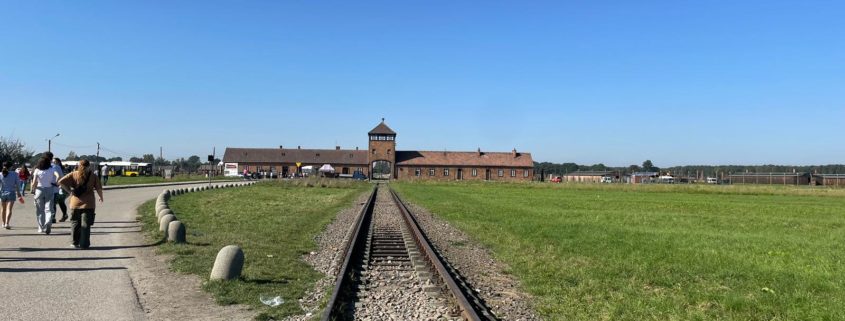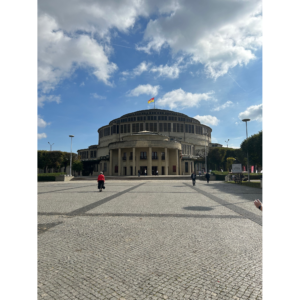The Importance of the United Nations Educational, Scientific and Cultural Organization
By Kennedy Snyder
Throughout our time on the traveling seminar, I have found myself repeatedly becoming confused and uncertain about the United Nations Educational, Scientific and Cultural Organization (UNESCO) and the World Heritage Sites. I had so many questions that returned at the many sites we visited. Three sites in Poland particularly caught my attention: Malbork Castle, Centennial Hall, and Auschwitz-Birkenau. Through our seminar discussions and my own research, I was able to answer some of my questions and lessen my confusion. I think if I had these questions other may too, so I am sharing my findings. I was intrigued by how UNESCO selects sites to be included on the World Heritage Site list. More broadly, I was also interested in knowing if being on the UNESCO World Heritage List negatively impact the sites.
UNESCO was founded in London on November 16, 1945, but started operations a year later. At present the organization has 194 member states, 12 associate members and is globally recognized. At the heart of its written mission is the ideal “The world needs humanity”, a statement from their website that really captured my attention. That quote stands firm in the fact that humanity is nothing to hide or be ridiculed for, but rather a uniting factor. During my research I looked at the history of UNESCO and learned more about the organization and its impact on the world. It operates in three main fields: Education, Science and Culture, which includes world heritage sites. UNESCO’s focus on world heritage is governed by the World Heritage Convention. To date, UNESCO has recognized 1,154 World Heritage Sites in the world and has protected many sites for their “universal value”. I found myself wondering what requirements must be met for sites to be considered to have “universal value”. After a bit of research, I found the full list of requirements. Yet, fundamentally, a site “must be of outstanding universal value and meet at least one of the ten selection criteria”. Considering the ten UNESCO criteria, one common thread ties together all the sites to be included on the list, a site must have value for all of humanity, it cannot be of value for a single country or region, race, or religion. Instead, must be something that every single human can see and appreciate or understand.
The Castle of the Teutonic Order in Malbork was placed on the UNESCO World Heritage List in 1997 because of a several reasons. Mainly, the castle shows a period of medieval history as well as being an impressive architectural feat as the largest gothic castle in the world by land area. The castle also brings the Teutonic Knights and their impact on the world back into present society. Before visiting the castle, the last time I was involved in an educational discussion of knights, I was in a high school history course. Malbork castle has yet to be fully renovated, however reconstruction work was completed after the Second World War in 1945 when more than half of the castle was destroyed. The castle was targeted not because it was important militarily, or because it was a strategic trade location, but simply because it meant something to Polish society, it was an emotional symbol of power and cultural tradition. This castle has gone through many phases of reconstruction work since the first damages from of the Thirty Years War ending in 1648. According to my research the fact that these reconstructions continue to be done after each suffered damage, the castle is now viewed as a monument to conservation, and restoration. Many forgotten medieval art and craft techniques have been rediscovered, along with a development of research and conservation theory and practice. Sadly though, multiple parts of the castle have been truly lost and cannot be rebuilt or reconstructed. The castle’s ownership changed hands many times over the century, and many changes have been introduced. Some rooms once painted with colorful murals, now have white walls, and new flooring, which caused the Castle to lose some of its historical value. Without UNESCO, the castle might have continued to be passed around rather than being protected and preserved for generations to come.
Centennial Hall is in Wroclaw, Poland. During our time in Wroclaw, we had a class that focused on Centennial Hall and its impact on Poland and the world. The Hall was built between 1911 and 1913 and is a modernism in architecture at its core. However, since it is an example of early modernism it does not have all the features that fully coincide with modernist architecture of later periods. The roof is not flat but features a huge dome, at the time of completion was the largest dome span in the world at 65 meters in diameter, with many large windows. The Hall was built not for one single purpose, but as a space that could be used for a large variety of events and activities and can house 10,000 people. Also important is that it was built of reinforced concrete which at the time of construction had not been used in such a way in public architecture.
UNESCO chose this site to be included on the World Heritage List in 2006 because of the architecture and technology that went into creating this building: the reinforced concrete building materials, the large dome, the use of steal in structural consideration, and the windows. When I went inside the Hall in the main arena under the dome, it was one of the most impressive buildings I have ever seen. The echo in the room is a phenomenon for me, and the sheer size is still hard to accept knowing the era of construction. Also, there was so much light in the room with the many layers of windows. It is just a remarkable and impressive creation. Today, the building is known by two names, Centennial Hall, and People’s Hall. The name the People’s Hall was given to the building after the end of WWII, when German Breslau became Polish Wroclaw. This change was symbolic for Poles when they were settling in these new territories. The People’s Hall is a way to show how architecture reflects the historical and social changes in societies after war. It is said the “Hall is characterized by extremely strong magnetism. It attracts everyone equally – after all, it is the Cathedral of Democracy”. In recent years, the Hall has been used for musicians, opera super-productions, film screenings, trade fairs, sports events, and even the Dalai Lama.
Auschwitz Birkenau, German Nazi Concentration and Extermination Camp, located near Krakow, Poland, is the only Nazi death camp that is on the UNESCO World Heritage list. The reason that a death camp could even be considered being placed on the list is that this camp represents a period in history that should never be forgotten. Auschwitz was the biggest and most infamous concentration and extermination camp that was in use when the Nazi’s were in power in Germany and occupied Poland. With UNESCO’s emphasis on humanity, I struggled with the idea of why a death camp would be chosen for the list. However, after reading the criteria these sites are not about celebrating humanity, but rather protecting important historical memories and events, and then I came to understand the situation differently. The thing about this site that was hard for me to rationalize, is that it was created by Germans to murder Poles, Jews, Roma, and other prisoners of war, yet it was placed on the World Heritage List in 1979. Thankfully not for why the Germans created it, but rather for the memory of what it now represents. The site attempts to ensure that nothing like the devastation of the Holocaust will ever be allowed to be repeated, and it is now viewed as a monument to the strength of the human spirit. Auschwitz Birkenau is a site that needs to be preserved and protected for many future generations to come, because we must never forget and always remember both phrases used when this period of history is discussed. This site is important to everyone – all humanity not just those who it directly impacted – as a warning so that this period of history may not ever be repeated, in any capacity.
Because the main criteria in selecting World Heritage Sites (WHS) is tied to its value to humanity and its universal value, the sites become appealing to everyone. Being on the list in a way promotes the countries where these sites are located, think of it like WHS is a free PR firm! The list attracts tourism, which is both an advantage and a disadvantage. According to a travel journal regarding tourism it claims that tourists positively affect economies by visitors contributing to the local business and restaurants. However, the increased interest in these sites also brings with it the increase in human-site interactions, effecting the reconstruction, renovations, and longevity of these sites. When we went to Auschwitz I, we saw firsthand how the site has changed by the large number of visitors. In the brick barracks, the stairsteps are no longer flat, but instead they have been worn down and indented by the millions of feet that had walked up and down them. Similarly, at Auschwitz II, we saw the indented floors that were the result of many people walking on them in the wooden barracks. This seems to be a consistent balancing issue, showcasing the sites for purposes of their selection criteria while preserving their structural integrity for years to come. One option to maintain the balance between tourism and site damage would be through the creation of a virtual tour. Visitors could appreciate the sites, without the destruction of the sites. Auschwitz Birkenau is just one of the multiple examples of tourism affecting the integrity of the World Heritage sites, according to the museum website.
UNESCO and the World Heritage List are overall an asset to the world as a way to protect great feats of humanity, and a way to never forget our origins. However, UNESCO will likely continue to struggle with the balance of tourists, natives, and site preservation challenges. Yet, we owe it to all of humanity, especially those we’ve lost, to keep their memories alive, as well as their achivements.
References
- UNESCO History of UNESCO https://www.unesco.org/en/history
- UNESCO World Convention The Criteria for Selection https://whc.unesco.org/en/criteria/
- Mariani, M. M., & Guizzardi, A. (2020). Does Designation as a UNESCO World Heritage Site Influence Tourist Evaluation of a Local Destination? Journal of Travel Research, 59(1), 22-36. https://journals.sagepub.com/doi/10.1177/0047287518821737
- Auschwitz-Birkenau State Museum (2007) Change to the Auschwitz Entry on the UNESCO World heritage List https://www.auschwitz.org/en/museum/news/change-to-the-auschwitz-entry-on-the-unesco-world-heritage-list,450.html
- Hala Stulecia History of The Centennial Hall https://halastulecia.pl/en/about-the-hall/history-of-the-centennial-hall/
- UNESCO World Heritage Convention Auschwitz Birkenau German Nazi Concentration and Extermination Camp (1940-1945) https://whc.unesco.org/en/list/31/
- Andrew G. McClelland (2016) The Management of Heritage in Contested Cross-border Contexts: Emerging research on the island of Ireland ResearchGate https://www.researchgate.net/publication/313315204_The_Management_of_Heritage_in_Contested_Cross-border_Contexts_Emerging_research_on_the_island_of_Ireland#pf4
- UNESCO World Convention Castle of the Teutonic Order in Malbork https://whc.unesco.org/en/list/847/
- Marta Jazowska (2013) Along Poland’s UNESCO Path Culture https://culture.pl/en/article/along-polands-unesco-path
- UNESCO World Convention Centennial Hall in Wrocław https://whc.unesco.org/en/list/1165/#:~:text=Criterion%20(ii)%3A%20The%20Centennial,development%20of%20reinforced%20concrete%20structures







